|
Kasparov & Deep Junior fight to 3-3 draw! |
||
|
The 1st "Man vs. Machine" World Championship came to a end on yesterday and ended in a 3-3 draw. GM Garry Kasparov, the world's #1 player for the last 18 years took on Deep Junior, the world's strongest chess program for personal computers. The silicon behemoth was built by Israeli programmers, Amir Ban and Shay Bushinsky. They received support from Israeli Grandmaster GM Boris Alterman. The six-match was called by GMs Maurice Ashley and Yasser Seirawan who also commentated the Kasparov-Deep Blue match. The game featured classic time controls (seven hours total). Kasparov started strong by crushing Deep Junior in Game 1 and was perhaps a move or two from winning Game 2 before making an error. That game ended in a draw and after Kasparov blundered horribly in Game 3 to tie the match score, the other games were drawn. Kasparov had chances to win in Games 5 and 6, but he played cautiously and the match ended in a draw. |
||
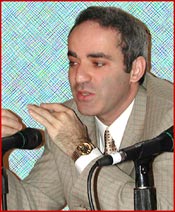
|
|
||
|
Game 1 (26 January 2003) Everyone in the chess world wondered what approach Kasparov would take against Deep Junior. GM Vladimir Kramnik's "anti-computer" style almost worked until he tried to get tactical. However, Kasparov went right after Deep Junior with the bold "Shabalov-Shirov" gambit 7.g4!? Kasparov's "manhandled" the computer in a fine display of power and surgical technique. Kasparov served up home cooking on the board with 13.d5! threatening a crushing bind on the white squares. Deep Junior decided to eliminate the light-squared bishop, but allowed a towering knight on d6. Eventually Deep Junior had to sacrifice an exchange, Kasparov tightened the screws and with 27.Rc7 and the Deep Junior team resigned. |
||
|
Game 2 (28 January 2003) Coming off of a convincing win, perhaps it's a good idea to play conservative with the black pieces, but thus far, Kasparov has violated all the anti-computer strategies. With the Najdorf usually "on automatic," Kasparov played a sharp line of the Paulsen after 1.e4 c5 2.Nf3 e6 3.d4 cxd4 4.Nxd4 a6 5.Bd3 Bc5!? |
||
|
|
Game: Deep Junior ½ - Kasparov ½ - (ChessBase team) |
||
|
Game 3 (30 January 2003) Kasparov continues to go blow-for-blow in his match with the silicon beast. With Kasparov's cunning change of move order, Deep Junior found itself in the same inferior position from Game 1. This time Junior bit the bait and landed into trouble after 10.g4!? Nxg4 11.Rg1 Ndf6 12.h3 Nh6 13.e4! Kasparov continued to open lines and charged on with 19.0-0-0 and prepared to assault black's damaged kingside. The game began to peter out after Junior played flawless defense, so Kasparov decided to grab the draw, but he erred with 32.Rh5? (32.Ng6+ drew immediately). After 32…Nxd4! Kasparov saw that he would be mated after 33.Ng6+ Kg8 34.Ne7+ Kf8 35.Rxh7 Nb3+! so he played 33.Nd5 and resigned after 33…Qg7 34.Qxd4 Rxd5. |
||
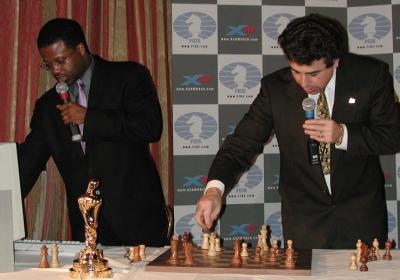
|
GMs Maurice Ashley and Yasser Seirawan provide commentary on Game 3. Photo courtesy of Chessbase.com. |
||
|
Game 4 (2 February 2003) This was perhaps the most intriguing battle in the match thus far. A classical battle ensued after Kasparov assumed the solid, but flexible "hedgehog" setup. Many players on the ICC kept complaining about black's passivity, but what makes the hedgehog such a dangerous weapon is that white finds it tempting to attack only to overextend and watch grimly as black's pieces spring to life with a vengeance after a move like …d5!, or …b5! In fact, commentator GM John Fedorowicz stated that he may have opted for such move earlier. |
||
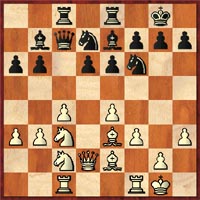
|
Kasparov unveils the solid and flexible hedgehog." The following formation occurred after 18…Ned7. |
||
|
Part of the maneuvering commonly seen is the movement of the knights. One viewer pointed out in one point of the game that the knights had accounted for 30% of the game's moves! After dancing the "knight's tango" for the better part of the middle game, white launched a queenside initiative with 24.a5 axb5 25.b5!? Bb7 26.b6. Black continued to probe with the knights and the game picked up steam after 38.c5!? |
||
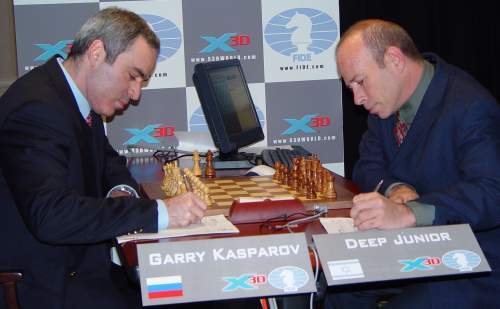
|
GM Garry Kasparov preparing to face off against Deep Junior in Game 5. Photo by John Henderson. |
||
|
Game 5 (5 February 2003) Not a crowd favorite. Kasparov has gone from the indomitable player who routinely grinds all human opposition to sawdust to a mortal of a chess player groveling for draws. Game 5 started as a Nimzo-Indian when Deep Junior attempted an unsound piece sacrifice with 10…Bxh2+?! 11.Kxh2 Ng5+ 12.Kg3 (12.Kg1?? Qh4-+) 12…Qg5. Commentators point out that this idea is simply refuted after 13.f4 Qh5 14. Bd2 Qh2+ 15.Kg3 Qh4 and now 16.g3! instead the text 16.Bxh7+? The game ended in a three-fold repetition. |
||
|
Game 6 (7 February 2003) With an estimated 200-300 million viewers watching this finale, pressure was said to have been so thick at the New York Athletic Club, you could cut it with a knife. Game 6 of the highly-publicized match between world's #1 player Garry Kasparov and Deep Junior was aired on America's ESPN2 and was hosted live by Jeremy Schapp. Ashley and Seirawan once again provided enlightening move-by-move commentary in a game to decide the champion of the 1st "Man vs. Machine" World Championship. |
||
|
In the first few moves of the game, Kasparov employed a "wrinkle" by playing 2…d6 and going into the Najdorf Sicilian. Those who follow international chess will know that this is normal for Kasparov, but he has employed two different variations in Games 2 and 4 achieving very good positions. So the theoretical battle was on! |
||
|
The tension continued to build as is common in Sicilian battles. After 15.Rad1, GM Seirawan spotted a familiar theme in this unbalanced position… the exchange sacrifice on c3. Seirawan's method was …Rc7, …Qa8, …Rfc8, …Rxc3. Two moves later after 16…Qc7, GM Ashley suggested …Qb8, …Qa8, …Rxc3. What was certain was that this move represented the central idea for black. |
||
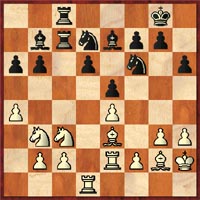
|
After Deep Junior's 23.Nb3?! Garry Kasparov played the thematic 23…Rxc3! And was on top after 24.bxc3 Bxe4. |
||
|
During the commentary both Ashley and Seirawan praised black's play and stated that Kasparov had definite winning chances. The mood swiftly changed when it was discovered that Kasparov had offered a draw after playing the move! Both commentators were at a loss to explain the gesture, but concluded that Kasparov had become "spooked" and feared losing despite being in a position not only rich in play, but favoring black. The Deep Junior operators returned the draw offer after 28.f4 after which Kasparov accepted amidst boos from the viewing hall. Words associated with the result were "surprising," "disappointing," " dissatisfying," and "outrageous." Ironically, strong computer program Fritz 8 gave Kasparov a slight edge after 28…f6. |
||













